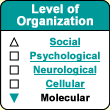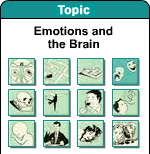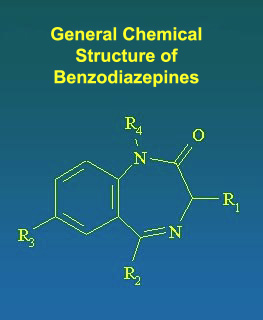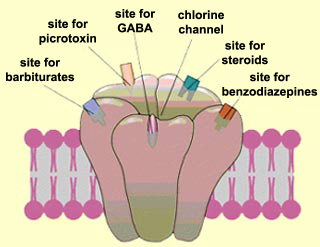|
|
|
|
 |
| Fear, Anxiety and Anguish |
 |
|
|
|

The first synthetic benzodiazepines were marketed by Hoffmann-La Roche in 1960, with chlordiazepoxyde (Librium) followed in 1963 by diazepam (Valium). Now there are some fifty different commercial forms.
Another category of medications that act on serotonin levels are the serotonin-specific reuptake inhibitors (SSRIs), the most famous of which is Prozac (generic name: fluoxetine). These molecules prevent serotonin from being reabsorbed by the presynaptic neuron after it has been released into the synaptic gap. Initially this results in an increase in the amount of serotonin in the synapse. In the longer run, it reduces the neurons’ serotonin content.
|
|
|
| ANXIETY NEUROTRANSMITTERS |
|
Since scientists discovered the mechanism
by which benzodiazepines act
to alleviate anxiety, all the evidence has indicated that the neurotransmitter
GABA and its receptors play a fundamental role in controlling anxiety.
|
|
After benzodiazepines
are ingested, they bind to a specific site on the GABA
receptor. The presence of benzodiazepine on this site
potentiates the effect of the GABA, further diminishing the
brain hyperactivity associated with anxiety.
As happens with many drugs, some endogenous
molecules analogous to benzodiazepines have been isolated
in the brain. These molecules appear to be a natural means
of adjusting the neuron-inhibiting action of GABA. |
Various aspects of anxiety also seem to be influenced by other
systems of neurotransmitters. Many laboratories are investigating
the role of serotonin in
particular. This molecule, produced mainly in the Raphe
nuclei in the brainstem, is known for its modulating effect
on appetite, sleep, mood, libido, and cognitive functions. All
of these functions are disturbed by anxiety.
The hypothesis that serotonin plays a role in anxiety is also
supported by the close connections between this neurotransmitter
and the locus
coeruleus, the centre of norepinephrine production
in the brain, which has very dense projections to the amygdala.
In fact, the serotonin and norepinephrine systems are so closely
bound together by numerous reciprocal connections that a modification
in one inevitably affects the other.
It is also known that the effect of
norepinephrine on the amygdala’s
beta-adrenergic receptors causes emotionally
charged events to be recorded more permanently in memory.
|
|






